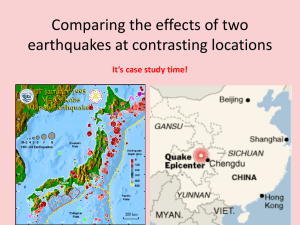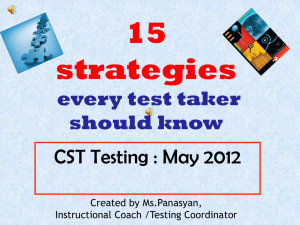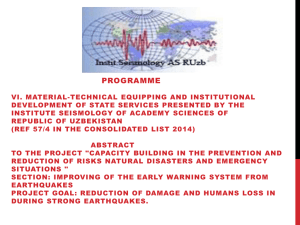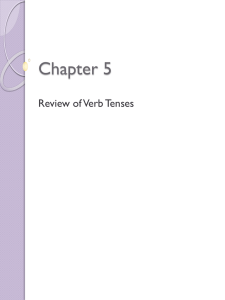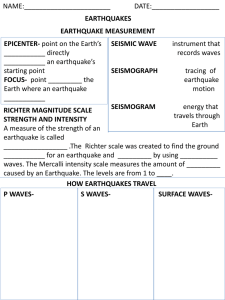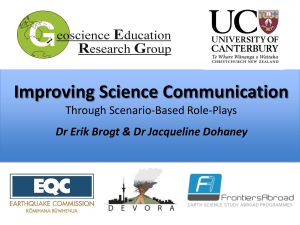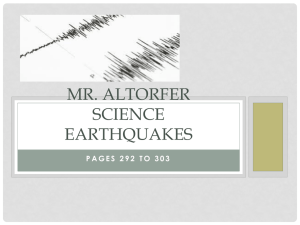EARTHQUAKES WebQuest
advertisement
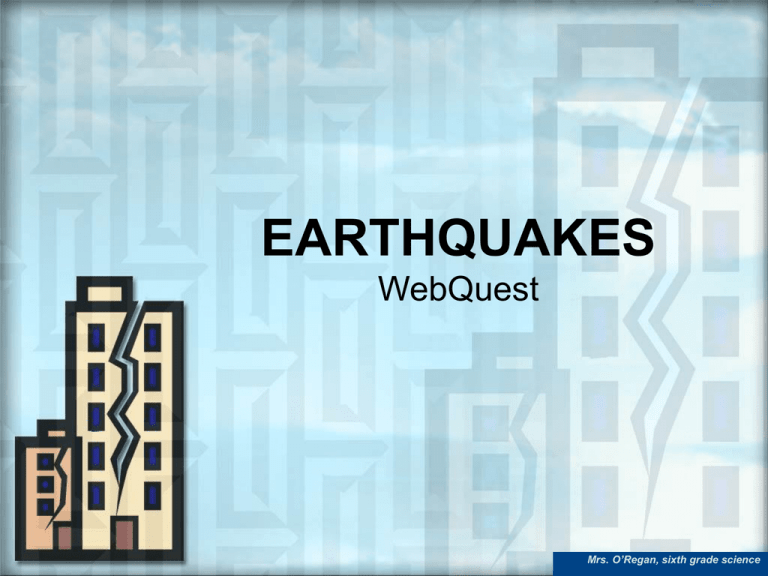
EARTHQUAKES WebQuest Mrs. O’Regan, sixth grade science INTRODUCTION TASK PROCESS EVALUATION CONCLUSION RESOURCES INTRODUCTION You and your partner are famous seismologists. You have been hired to create a presentation for a third grade class that would explain where, how and why earthquakes happen. INTRODUCTION TASK • PROCESS CONCLUSION RESOURCES TASK You are to create a presentation that would accurately explain the where, when, why and how of earthquakes to elementary school students. All information can be found within the websites and within your science textbook. The topics that MUST be addressed are as follows: • • • • • • • EVALUATION The different types of plate boundaries The different types of faults The different types of seismic waves The focus and the epicenter The three scales used for measuring earthquakes Seismographs and seismograms You may present your project as a poster, a book, or a PowerPoint presentation. (If you have other ideas, please see me before you get started.) – Since this project is geared toward third graders, you are limited to no more than 75 words to describe each of the topics. That allows you enough words to create brief captions for each of the subtopics. Keep your explanations accurate, but short. – Be aware of a third grader’s vocabulary when you write your descriptions. You must include the vocabulary words, but your explanations need to be in third grade terms. • You must create at least one 3-D model. It can be used to illustrate any one of the six bulleted topics. Your model can be anything from a pop-up book to a diorama to a clay model. It does not have to be big in size. Be creative. Use things that you have around the house! INTRODUCTION TASK PROCESS EVALUATION CONCLUSION RESOURCES PROCESS • • • • • • • • • • • Take out three pieces of paper and list each of the bulleted topics on one side of the paper so that you have one topic on each of the six sides of your paper. Look up your topics to see how many sub categories there are. For example… there are 3 different types of plate boundaries. You need to discuss all of them. Write down the names, then write down information you discover about them. Gather information about all the topics. Sort through your information to write a good, yet short description for each of your subtopics and topics. Remember that each of the six bulleted topics can have no more than 75 total words. Should you make a poster, a book, or a PowerPoint? Decide how to best present your project. Are you looking for pictures on the internet or out of magazines? Will you draw your pictures? Will you type or handwrite your information? Make sure that all components are neat, spelled correctly, colored/glued neatly. Overall neatness and visual appeal of your project counts! Decide which of the six topics would make the best kind of project for you. You are only to choose 1. Create your 3-D model. It needs to be factual and neat. Write one paragraph to explain what your project is, why you chose to do that, and show how your project illustrates your topic. You and your partner will present your total project to the class. INTRODUCTION TASK PROCESS EVALUATION CONCLUSION RESOURCES EVALUATION Process Below Avg. Satisfactory Excellent 1. Has everything collected and in class--ready to begin the project. 1, 2, 3 4, 5, 6 7, 8, 9 2. Was properly organized and had enough information to complete project 1, 2, 3 4, 5, 6 7, 8, 9 3. Managed class work-time wisely 1, 2, 3 4, 5, 6 7, 8, 9 Below Avg. Satisfactory Excellent 1. The project contained all the listed topics and subtopics. 1, 2, 3 4, 5, 6 7, 8, 9 2. Mechanics of writing (spelling and grammar) are correct. 1, 2, 3 4, 5, 6 7, 8, 9 3. Organization and structure makes sense 1, 2, 3 4, 5, 6 7, 8, 9 4. Creativity: The project is neat and has visual appeal. 1, 2, 3 4, 5, 6 7, 8, 9 5. The topics are fully explained in detail using 75 words or less. 1, 2, 3 4, 5, 6 7, 8, 9, 10 6. All graphics used make sense and are relevant. 1, 2, 3 4, 5, 6 7, 8, 9 7. Extra points for extra clever and creative work: 0, 1, 2, 3 4, 5, 6 7, 8, 9 8. The entire project is well put together. This means that PowerPoint presentations are organized, there are transitions, and the elements used do not take away from the overall message. Books and posters must be neat and without cross-outs. Anything added to the poster or book needs to be securely fastened. 1, 2, 3 4, 5, 6 7, 8, 9, 10 9. The 3-D model is well thought out and relevant. The 1paragraph explanation makes sense. 1, 2, 3 4, 5, 6 7, 8, 9, 10 Product (Project) INTRODUCTION TASK PROCESS EVALUATION CONCLUSION RESOURCES CONCLUSION • To successfully complete this WebQuest, you and your partner must work as a team. • Double check that you have followed all of the procedures and requirements correctly. • Double check your projects against the evaluation rubrics – Poster has all topics and subtopics – All words within the project are accurate and spelled correctly – All information is factual – Each of the six topics (including the captions) is presented in 5 words or less – The project has visual appeal: it is neat in not only coloring and writing, but it also appears that there was much thought and time put into the project – The 3-D model is neat and accurate – You both know all of the information so that you can present it to the class in a short presentation INTRODUCTION TASK PROCESS EVALUATION CONCLUSION RESOURCES RESOURCES • • • • • • Videos Animations and Interactive Sites Facts General Earthquake Resources Up-to-the-Minute Earthquake Information Engineering & Building in Earthquake Country • Earthquake Preparedness INTRODUCTION TASK PROCESS EVALUATION CONCLUSION RESOURCES VIDEO RESOURCES • • • • • • • • • • • National Geographic Videos Kobe Earthquake Footage (no sound) NOVA on Teachers’ Domain: Earthquakes Plate Tectonics: An Introduction Earthquakes: The Prehistoric Record Earthquakes: The Seismograph Making a Seismometer Earthquake Prediction Earthquakes: San Francisco Earthquakes: Los Angeles Southern California Earthquake Center: Movies and Animations Teachers’ Domain… login: mrsoregan /password: rcms INTRODUCTION TASK PROCESS EVALUATION CONCLUSION RESOURCES ANIMATIONS & INTERACTIVE RESOURCES • • • • • • • ShakeZone for Kids from California State University Northridge ABC new Interactive Guide to Earthquakes Educational Multimedia Visualization Center: Animations Fault Motions Animation Incorporated Research Institutions for Seismology (IRIS) – ANIMATIONS Savage Earth: Earthquakes Animations Discovery: Make your own Earthquake • • • • • • • • 1906: The Great Quake Cover-Up “San Francisco Is Gone” (Famous Perspectives) Photo Gallery: And the World Shook Anatomy of a Tsunami Seismic Signals Tectonic Plates and Plate Boundaries Mountain Maker, Earth Shaker Earth Science Explorer Teachers’ Domain… login: mrsoregan /password: rcms INTRODUCTION TASK PROCESS EVALUATION CONCLUSION RESOURCES FACTS • • • • • • • • • More Earthquake Facts (Center for Earthquake Research and Information—CERI) Earthquake facts Earthquake Glossary (USGS) Earthquake topics (USGS) Earthquake Information (InfoPlease) UPSeis…an educational site for budding seismologists Fact Monster: Earthquakes The Science of Earthquakes (USGS) FEMA for Kids INTRODUCTION TASK PROCESS EVALUATION CONCLUSION RESOURCES GENERAL RESOURCES • • • • • • • • • • • • • • The Tech: Earthquakes Overview Faultline: Seismic Science at the Epicenter LA Times Quake Primer The Great California Shake Out Exploring Earthquakes Earthquakes for kids (USGS) Advanced Earthquake Information (USGS.gov) Earthquakes (NASA): Click on the pink book Putting Down Roots in Earthquake Country Weather Wiz Kids--Earthquakes Kidipede: Earthquakes The Virtual Museum of the City of San Francisco Earthquake Powerpoints Documenting Earthquakes: A Virtual Exhibit in Six Parts INTRODUCTION TASK PROCESS EVALUATION CONCLUSION RESOURCES UP-TO-THE-MINUTE EARTHQUAKE INFO • • • Real-Time Earth Monitors Earthquakes at USGS Worldwide Earthquake Locator INTRODUCTION TASK PROCESS EVALUATION CONCLUSION RESOURCES ENGINEERING & BUILDING IN EARTHQUAKE COUNTRY • • Engineering ShakeZone for Kids from California State University Northridge INTRODUCTION TASK PROCESS EVALUATION CONCLUSION RESOURCES BEING PREPARED • • Great California Shakeout: an audio broadcast of what to do How to Survive an Earthquake

